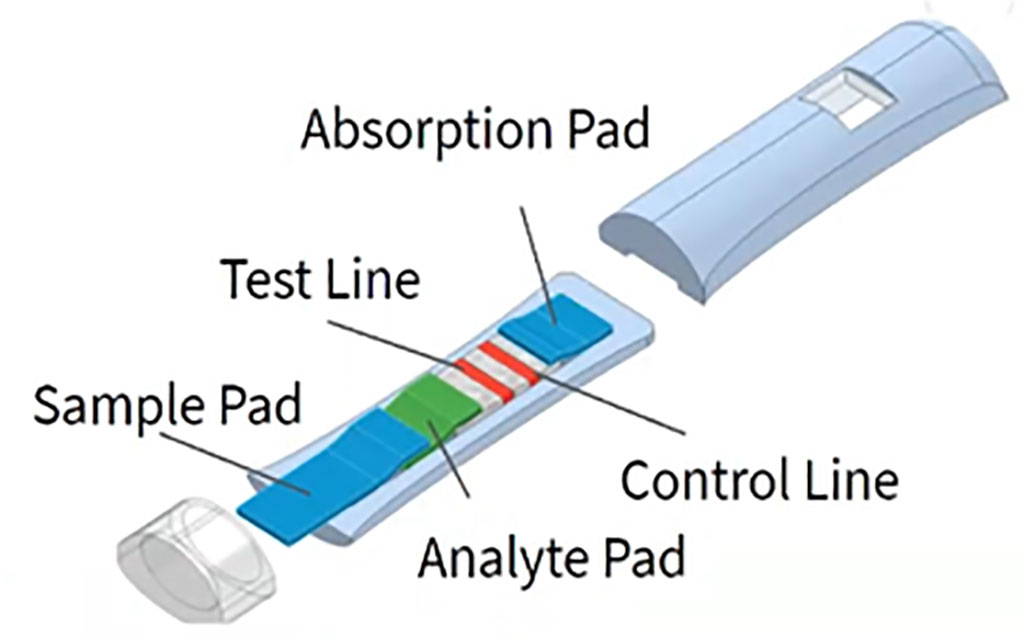Portable Rapid Diagnostic Assay Identifies Hemorrhaging Patients Using Small Blood Sample
|
By HospiMedica International staff writers Posted on 29 Aug 2023 |

Hemorrhaging occurs when blood vessels are damaged due to a traumatic event, leading to either visible external or hidden internal bleeding. While external bleeding is easily detectable, internal bleeding, also referred to as internal hemorrhaging, remains hidden from plain sight. Diagnosing internal bleeding demands clinical suspicion and subsequent assessment. Within hospital settings, advanced imaging can confirm these assessments, enabling timely surgical intervention to save lives. However, current methods for detecting hemorrhage are insufficient and require skilled operators, presenting significant diagnostic challenges. Now, a revolutionary internal hemorrhage diagnostic tool could change all that.
DioTeX Diagnostics (Baltimore, MD, USA), comprising a team of undergraduate biomedical engineers from Johns Hopkins University (Baltimore, MD, USA), is developing a portable, dependable, and accessible internal hemorrhage diagnostic tool. Their approach involves using a specific biomarker associated with hemorrhage to create a rapid immunochemistry-based test. By analyzing a small blood sample, this tool can swiftly identify patients with internal bleeding. This test has the potential to revolutionize internal hemorrhage diagnosis, as it can be conducted accurately and consistently by individuals with minimal training. This innovation holds the promise of faster and more appropriate hemorrhage care, potentially saving thousands of lives annually.
DioTeX has built a prototype of its portable rapid diagnostic assay designed to detect blood biomarkers linked to trauma-induced hemorrhage. This advancement aims to enhance the evaluation and management of internal trauma. Using the device, critical diagnostic results can be obtained and interpreted by anyone, regardless of location. To utilize the device, a blood sample is collected from behind the ear of a patient who may be experiencing internal bleeding. This process employs DioTeX's proprietary blood drawing mechanism. After approximately 5 minutes, users can interpret the test device's reading. A single line indicates no hemorrhage, while two lines indicate the presence of bleeding. The testing device requires minimal training, making it practical for use in settings with limited resources and in rural areas.
Related Links:
DioTeX Diagnostics
Johns Hopkins University
Latest Point of Care News
Channels
Critical Care
view channel
Ingestible Smart Capsule for Chemical Sensing in the Gut Moves Closer to Market
Intestinal gases are associated with several health conditions, including colon cancer, irritable bowel syndrome, and inflammatory bowel disease, and they have the potential to serve as crucial biomarkers... Read moreNovel Cannula Delivery System Enables Targeted Delivery of Imaging Agents and Drugs
Multiphoton microscopy has become an invaluable tool in neuroscience, allowing researchers to observe brain activity in real time with high-resolution imaging. A crucial aspect of many multiphoton microscopy... Read more
Novel Intrabronchial Method Delivers Cell Therapies in Critically Ill Patients on External Lung Support
Until now, administering cell therapies to patients on extracorporeal membrane oxygenation (ECMO)—a life-support system typically used for severe lung failure—has been nearly impossible.... Read moreSurgical Techniques
view channel
Pioneering Sutureless Coronary Bypass Technology to Eliminate Open-Chest Procedures
In patients with coronary artery disease, certain blood vessels may be narrowed or blocked, requiring a stent or a bypass (also known as diversion) to restore blood flow to the heart. Bypass surgeries... Read more
Intravascular Imaging for Guiding Stent Implantation Ensures Safer Stenting Procedures
Patients diagnosed with coronary artery disease, which is caused by plaque accumulation within the arteries leading to chest pain, shortness of breath, and potential heart attacks, frequently undergo percutaneous... Read more
World's First AI Surgical Guidance Platform Allows Surgeons to Measure Success in Real-Time
Surgeons have always faced challenges in measuring their progress toward surgical goals during procedures. Traditionally, obtaining measurements required stepping out of the sterile environment to perform... Read morePatient Care
view channel
Portable Biosensor Platform to Reduce Hospital-Acquired Infections
Approximately 4 million patients in the European Union acquire healthcare-associated infections (HAIs) or nosocomial infections each year, with around 37,000 deaths directly resulting from these infections,... Read moreFirst-Of-Its-Kind Portable Germicidal Light Technology Disinfects High-Touch Clinical Surfaces in Seconds
Reducing healthcare-acquired infections (HAIs) remains a pressing issue within global healthcare systems. In the United States alone, 1.7 million patients contract HAIs annually, leading to approximately... Read more
Surgical Capacity Optimization Solution Helps Hospitals Boost OR Utilization
An innovative solution has the capability to transform surgical capacity utilization by targeting the root cause of surgical block time inefficiencies. Fujitsu Limited’s (Tokyo, Japan) Surgical Capacity... Read more
Game-Changing Innovation in Surgical Instrument Sterilization Significantly Improves OR Throughput
A groundbreaking innovation enables hospitals to significantly improve instrument processing time and throughput in operating rooms (ORs) and sterile processing departments. Turbett Surgical, Inc.... Read moreHealth IT
view channel
Printable Molecule-Selective Nanoparticles Enable Mass Production of Wearable Biosensors
The future of medicine is likely to focus on the personalization of healthcare—understanding exactly what an individual requires and delivering the appropriate combination of nutrients, metabolites, and... Read more
Smartwatches Could Detect Congestive Heart Failure
Diagnosing congestive heart failure (CHF) typically requires expensive and time-consuming imaging techniques like echocardiography, also known as cardiac ultrasound. Previously, detecting CHF by analyzing... Read moreBusiness
view channel
Expanded Collaboration to Transform OR Technology Through AI and Automation
The expansion of an existing collaboration between three leading companies aims to develop artificial intelligence (AI)-driven solutions for smart operating rooms with sophisticated monitoring and automation.... Read more

















